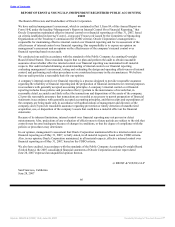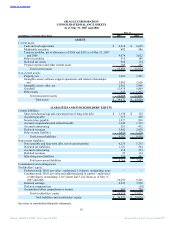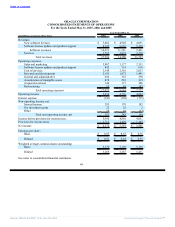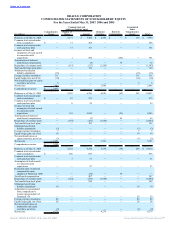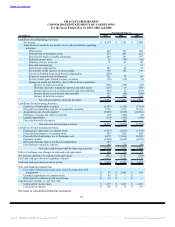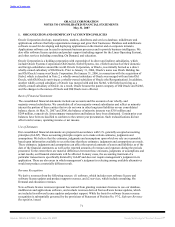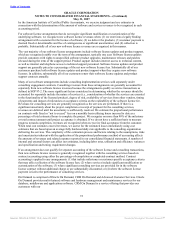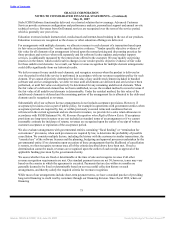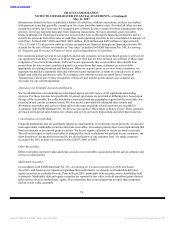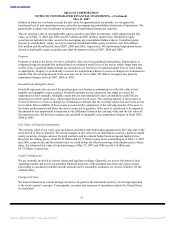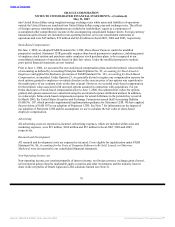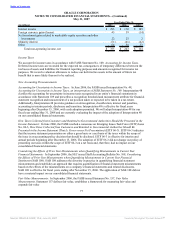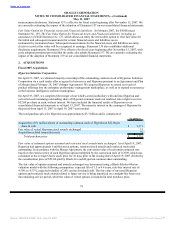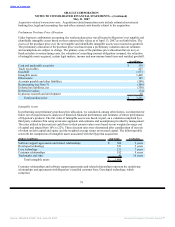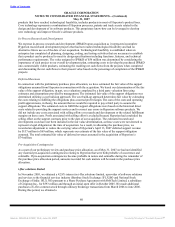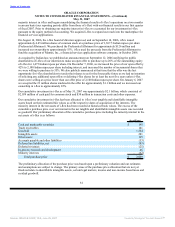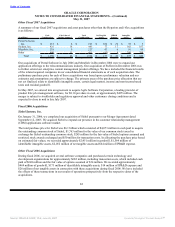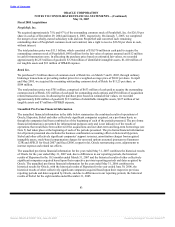Oracle 2006 Annual Report Download - page 80
Download and view the complete annual report
Please find page 80 of the 2006 Oracle annual report below. You can navigate through the pages in the report by either clicking on the pages listed below, or by using the keyword search tool below to find specific information within the annual report.
Table of Contents
ORACLE CORPORATION
NOTES TO CONSOLIDATED FINANCIAL STATEMENTS—(Continued)
May 31, 2007
division was formed, we have established a history of collection, without concessions, on these receivables
with payment terms that generally extend up to five years from the contract date. Provided all other revenue
recognition criteria have been met, we recognize new software license revenues for these arrangements upon
delivery, net of any payment discounts from financing transactions. We have generally sold receivables
financed through our financing division on a non-recourse basis to third party financing institutions and we
classify the proceeds from these sales as cash flows from operating activities in our consolidated statements of
cash flows. In fiscal 2007, 2006 and 2005, $891 million, $618 million and $456 million or approximately
15%, 13% and 11% of our new software license revenues were financed through our financing division. We
account for the sale of these receivables as “true sales” as defined in FASB Statement No. 140, Accounting
for Transfers and Servicing of Financial Assets and Extinguishments of Liabilities.
Our customers include several of our suppliers and on rare occasion, we have purchased goods or services for
our operations from these vendors at or about the same time that we have licensed our software to these same
companies (Concurrent Transaction). Software license agreements that occur within a three-month time
period from the date we have purchased goods or services from that same customer are reviewed for
appropriate accounting treatment and disclosure. When we acquire goods or services from a customer, we
negotiate the purchase separately from any software license transaction, at terms we consider to be at arm’s
length, and settle the purchase in cash. We recognize new software license revenues from Concurrent
Transactions if all of our revenue recognition criteria are met and the goods and services acquired are
necessary for our current operations.
Allowances for Doubtful Accounts and Returns
We record allowances for doubtful accounts based upon a specific review of all significant outstanding
invoices. For those invoices not specifically reviewed, provisions are provided at differing rates, based upon
the age of the receivable, the collection history associated with the geographic region that the receivable was
recorded in and current economic trends. We also record a provision for estimated sales returns and
allowances on product and service related sales in the same period the related revenues are recorded in
accordance with FASB Statement No. 48, Revenue Recognition When Right of Return Exists. These estimates
are based on historical sales returns, the volume and size of our larger transactions and other known factors.
Concentration of Credit Risk
Financial instruments that are potentially subject to concentrations of credit risk consist primarily of cash and
cash equivalents, marketable securities and trade receivables. Investment policies have been implemented that
limit investments to investment grade securities. We do not require collateral to secure accounts receivable.
The risk with respect to trade receivables is mitigated by credit evaluations we perform on our customers, the
short duration of our payment terms and by the diversification of our customer base. No single customer
accounted for 10% or more of revenues in fiscal 2007, 2006 or 2005.
Other Receivables
Other receivables represent value-added tax and sales tax receivables associated with the sale of software and
services to third parties.
Marketable Securities
In accordance with FASB Statement No. 115, Accounting for Certain Investments in Debt and Equity
Securities, and based on our intentions regarding these instruments, we classify our marketable debt and
equity securities as available-for-sale. Prior to fiscal 2007, marketable debt securities were classified as held
to maturity. Marketable debt and equity securities are reported at fair value, with all unrealized gains (losses)
reflected net of tax in stockholders’ equity. If we determine that an investment has an other than temporary
decline in fair value, generally
74
Source: ORACLE CORP, 10-K, June 29, 2007 Powered by Morningstar® Document Research℠


